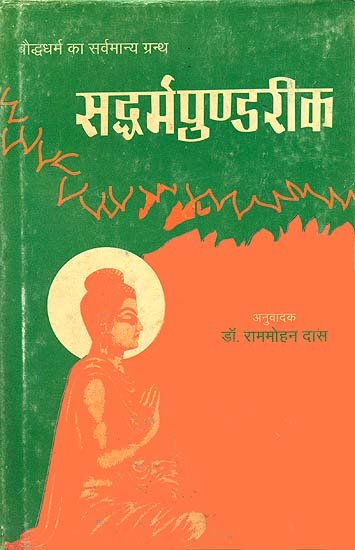Lotus Sutra (Saddharma-Pundarika) [sanskrit]
by H. Kern | 2013 | 16,351 words | ISBN-13: 9788120801226
The Lotus Sutra (Saddharma-pundarika) is an important Mahayana Buddhist scripture classified as one of the nine Dharmas. the Lotus Sutra deals with a wide range of important Buddhist teachings in twenty-seven chapters including the nature of the Buddhas and the inherent potentiality of becoming Buddha within all beings. This editions only contains the Sanskrit metrical text and the corresponding English translation. Alternative titles: Saddharma-puṇḍarīka-sūtra (सद्धर्म-पुण्डरीक-सूत्र).
Verse 3.101
ये चापि दुःखस्य अजानमाना मूलं न पश्यन्तिह बालबुद्धयः ।
मार्गं हि तेषामनुदर्शयामि समुदागमस्तृष्ण दुखस्य संभवः ॥ १०१ ॥
ye cāpi duḥkhasya ajānamānā mūlaṃ na paśyantiha bālabuddhayaḥ |
mārgaṃ hi teṣāmanudarśayāmi samudāgamastṛṣṇa dukhasya saṃbhavaḥ || 101 ||
And to those who are ignorant and too simple-minded to discover the root of that pain I lay open the way: “Awaking of full consciousness, strong desire is the origin of pain.”
English translation by H. Kern (2013) Buy now!
Glossary of Sanskrit terms
Note: This extracts Sanskrit terms and links to English definitions from the glossary, based on an experimental segmentation of verse (3.101). Some terms could be superfluous while some might not be mentioned. Click on the word to show English definitions.
Yah, Yat, Capin, Capi, Duhkha, Aja, Mula, Pashyanti, Pashyat, Han, Bala, Buddhi, Marga, Tad, Anudarsha, Yami, Yamin, Kha, Sambhava, Sambhu,
Analysis of Sanskrit grammar
Note: this is an experimental feature and only shows the first possible analysis of the Sanskrit text (Lotus Sutra Verse 3.101). If the system was successful in segmenting the sentence, you will see of which words it is made up of, generally consisting of Nouns, Pronouns, Verbs, Participles and Indeclinables. Click on the link to show all possible derivations of the word.
- Line 1: “ye cāpi duḥkhasya ajānamānā mūlaṃ na paśyantiha bālabuddhayaḥ ”
- ye -
-
ya (noun, masculine)[nominative plural]yā (noun, feminine)[nominative dual], [accusative dual]yaḥ (pronoun, masculine)[nominative plural]yat (pronoun, neuter)[nominative dual], [accusative dual]yā (pronoun, feminine)[nominative dual], [accusative dual]
- cāpi -
-
cāpin (noun, masculine)[compound], [adverb]cāpin (noun, neuter)[compound], [adverb], [nominative single], [vocative single], [accusative single]cāpī (noun, masculine)[compound], [adverb]cāpī (noun, feminine)[compound], [adverb], [vocative single]cāpī (noun, neuter)[compound], [adverb], [nominative single], [vocative single], [accusative single]cāpi (noun, masculine)[compound], [adverb]cāpi (noun, feminine)[compound], [adverb]cāpi (noun, neuter)[compound], [adverb], [nominative single], [vocative single], [accusative single]
- duḥkhasya -
-
duḥkha (noun, masculine)[genitive single]duḥkha (noun, neuter)[genitive single]
- ajān -
-
aja (noun, masculine)[accusative plural]
- amānā -
-
- mūlam -
-
mūla (noun, masculine)[adverb], [accusative single]mūla (noun, neuter)[adverb], [nominative single], [accusative single]mūlā (noun, feminine)[adverb]
- na -
-
na (indeclinable particle)[indeclinable particle]na (noun, masculine)[compound], [vocative single]na (noun, neuter)[compound], [vocative single]
- paśyanti -
-
paśyantī (noun, feminine)[adverb], [vocative single]paśyat (noun, neuter)[nominative plural], [vocative plural], [accusative plural]
- ha -
-
ha (noun, masculine)[compound], [vocative single]ha (noun, neuter)[compound], [vocative single]han (noun, neuter)[compound], [adverb], [nominative single], [vocative single], [accusative single]
- bāla -
-
bāla (noun, masculine)[compound], [vocative single]bāla (noun, neuter)[compound], [vocative single]
- buddhayaḥ -
-
buddhi (noun, feminine)[nominative plural], [vocative plural]
- Line 2: “mārgaṃ hi teṣāmanudarśayāmi samudāgamastṛṣṇa dukhasya saṃbhavaḥ ”
- mārgam -
-
mārga (noun, masculine)[adverb], [accusative single]mārga (noun, neuter)[adverb], [nominative single], [accusative single]mārgā (noun, feminine)[adverb]
- hi -
-
hi (indeclinable particle)[indeclinable particle]
- teṣām -
-
tad (noun, neuter)[genitive plural]sa (noun, masculine)[genitive plural]
- anudarśa -
-
anudarśa (noun, masculine)[compound], [vocative single]
- yāmi -
-
yāmī (noun, feminine)[adverb], [vocative single]yāmi (noun, feminine)[compound], [adverb]yāmin (noun, masculine)[compound], [adverb]yāmin (noun, neuter)[compound], [adverb], [nominative single], [accusative single]√yā (verb class 2)[present active first single]
- Cannot analyse samudāgamastṛṣṇa*du
- du -
-
dū (noun, feminine)[adverb], [vocative single]
- khasya -
-
kha (noun, masculine)[genitive single]kha (noun, neuter)[genitive single]
- sambhavaḥ -
-
sambhava (noun, masculine)[nominative single]sambhu (noun, masculine)[nominative plural], [vocative plural]sambhu (noun, feminine)[nominative plural], [vocative plural]
Other editions:
Also see the following editions of the Sanskrit text or (alternative) English translations of the Lotus Sutra Verse 3.101
The Lotus Sutra (The Saddharma-Pundarika)
by H. Kern (2013)
The Lotus Sutra (Text with Hindi Translation)
by Ram Mohan Das (2001)
![Lotus Sutra (Saddharma-Pundarika) [sanskrit] - book cover](/uploads/a/Lotus-Sutra.jpg)
